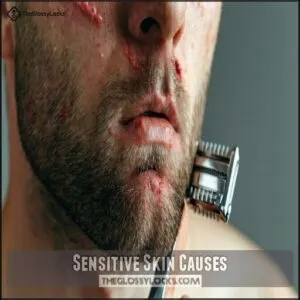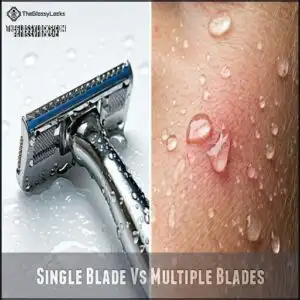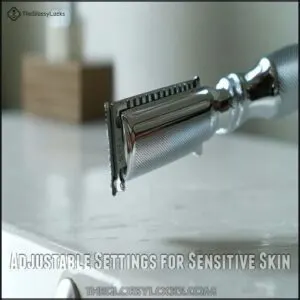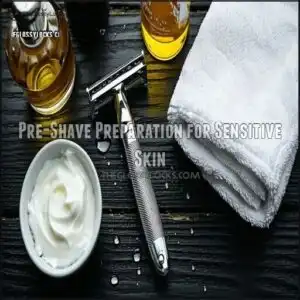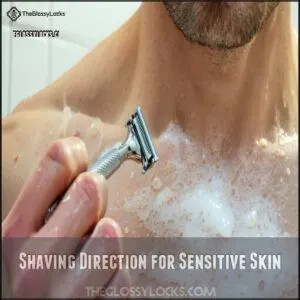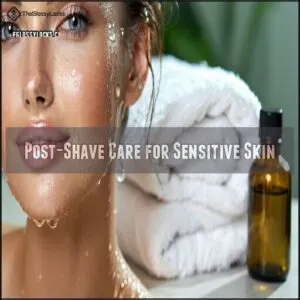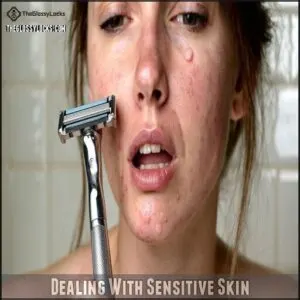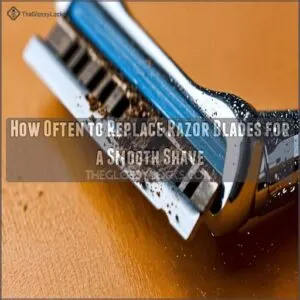This site is supported by our readers. We may earn a commission, at no cost to you, if you purchase through links.
 For sensitive skin, you’ll want a safety razor that’s gentle yet effective.
For sensitive skin, you’ll want a safety razor that’s gentle yet effective.
The Merkur Futur Adjustable tops our list as the best safety razor for sensitive skin because you can precisely control blade exposure.
The Bevel Safety Razor comes in close second with its weighted handle and single blade design that cuts at skin level, not below it.
If you’re budget-conscious, the Bulldog Sensitive Razor delivers impressive comfort without breaking the bank.
Remember, the right safety razor should feel like an extension of your hand, not a weapon against your face.
Finding your perfect match is about more than just the razor—it’s about the entire shaving ritual.
Table Of Contents
- Key Takeaways
- Sensitive Skin Causes
- Choosing Right Razor
- Top 9 Safety Razors
- 1. Panasonic Arc5 Electric Razor for Men
- 2. Braun Series 9 Pro Electric Razor
- 3. Gillette SkinGuard Razor for Sensitive Skin
- 4. Philips Norelco OneBlade Trimmer Shaver
- 5. Harrys Shave Kit for Men Charcoal
- 6. Bulldog Sensitive Razor with Stand
- 7. GilletteLabs Heated Razor Starter Kit
- 8. Bevel Shaving Kit for Men
- 9. Merkur Futur Adjustable Safety Razor
- Shaving Techniques Matter
- Maintaining Safety Razor
- Dealing With Sensitive Skin
- Frequently Asked Questions (FAQs)
- Should you use a safety razor If you have sensitive skin?
- Are safety razors safe?
- What are the best safety razor blades for sensitive skin?
- How do I choose a sensitive skin-friendly razor?
- Which Razor is best for sensitive skin?
- Which Shaver is best for sensitive skin?
- Do dermatologists recommend safety razors?
- Which is the mildest safety razor?
- What is the best razor for sensitive skin dermatologist?
- How do you prevent razor burn with a safety razor?
- Conclusion
Key Takeaways
- For sensitive skin, choose adjustable safety razors like the Merkur Futur that let you control blade exposure, or single-blade options like the Bevel that cut at skin level rather than below it.
- Proper technique matters as much as your razor choice—prepare with warm water and pre-shave oil, shave with the grain using light pressure, and finish with alcohol-free balm to minimize irritation.
- Materials affect compatibility with your skin; look for titanium alloys or austenitic stainless steel which form stable oxide layers that rarely trigger reactions in sensitive skin.
- Replace your safety razor blades every 5-7 shaves, as dull edges cause more tugging and redness than sharp ones, and store your razor upright in a dry place to prevent rust and bacteria buildup.
Sensitive Skin Causes
Your skin’s sensitivity isn’t just in your head—it’s often caused by specific conditions like irritant contact dermatitis from harsh soaps, allergic reactions to certain chemicals, or dermographism triggered by physical irritation.
You’ll notice these issues particularly when shaving, as the blade’s friction against your skin can aggravate these underlying conditions, making the right safety razor absolutely essential for preventing further irritation, especially due to physical irritation.
Irritant Contact Dermatitis
Irritant contact dermatitis is your skin’s SOS signal when it’s unhappy with certain substances.
This common sensitive skin condition occurs when irritants damage your skin’s protective barrier, causing inflammation.
Four common culprits behind irritant contact dermatitis include:
- Harsh soaps and shaving creams containing sulfates
- Alcohol-based aftershaves that dry out skin
- Dull razor blades creating microscopic skin tears
- Over-exfoliation before shaving, weakening skin defenses
Allergic Contact Dermatitis
Unlike irritant contact dermatitis, allergic contact dermatitis occurs when your immune system overreacts to specific substances in shaving products or razor materials.
You’ll notice symptoms developing 24-72 hours after exposure, often with more intense reactions each time.
| Common Allergens | Symptoms | Treatment Options |
|---|---|---|
| Nickel in razor metals | Redness and itching | Choose titanium or stainless steel razors |
| Fragrances in shaving creams | Blistering rash | Use fragrance-free products |
| Preservatives in aftershave | Swelling and pain | Apply patch testing before new products |
The key to managing allergic reactions is understanding the causes and taking preventive measures, such as choosing the right materials and products to minimize the risk of skin irritation.
Dermographism
When your skin develops raised red lines after being lightly scratched, you’re likely experiencing dermographism, commonly known as "skin writing."
This condition makes shaving particularly challenging, as razor friction can trigger symptoms instantly.
You’ll need specific shaving adaptations and proper safety razor sensitive skin techniques to manage this sensitivity.
Identifying your triggers (pressure, temperature changes, stress) helps develop effective strategies for comfortable shaving without the characteristic welts and irritation.
Choosing Right Razor
You’ll find that selecting the right safety razor for sensitive skin involves understanding materials, blade count, and adjustable features that work best with your unique skin needs.
When your face resembles a road map after shaving, it’s time to think about razors specifically designed to minimize irritation while still delivering that smooth, clean finish you’re after, which is why choosing the right razor is crucial for achieving a comfortable shave with minimal irritation.
Razor Materials and Biocompatibility
While understanding the causes of sensitivity helps you avoid triggers, selecting the right razor material is your first line of defense against irritation.
The metals touching your face matter more than you might think.
Here’s what makes a razor truly skin-friendly:
- Titanium alloys form a stable oxide layer that rarely triggers reactions
- Austenitic stainless steel offers superior corrosion resistance for sensitive skin
- Weight distribution affects pressure control and irritation levels
- Biocompatible materials reduce likelihood of redness and bumps
- Surface treatments on blades can enhance compatibility with reactive skin
Your safety razor isn’t just a tool—it’s basically medical-grade equipment making direct contact with your skin every day.
Many users are now exploring the benefits of a titanium made razor.
Single Blade Vs Multiple Blades
In the case of sensitive skin, less is definitely more in the blade count department.
Single blade razors substantially reduce irritation levels and razor burn compared to their multi-blade counterparts.
While cartridge razors with 3-5 blades might promise a closer shave, they actually create more friction against your skin.
Double edge razors excel for sensitive skin by cutting hair cleanly without the repeated trauma of multiple blades passing over the same spot.
Proper technique also includes warm water preparation before shaving, which is an important part of achieving a smooth shave with less irritation and using the right razor for your skin type, such as a double edge razor.
Adjustable Settings for Sensitive Skin
While single blades often win the battle against irritation, there’s another champion in your corner: adjustable settings.
With 6 customizable options, the best safety razor for sensitive skin lets you control blade gap and aggressiveness levels. You’re in charge of how much blade touches your face—perfect for skin sensitivity issues.
Mild razor settings create more distance between blade and skin, while pressure control becomes second nature with proper shave customization.
Top 9 Safety Razors
You’ll find the perfect match for your sensitive skin among these nine exceptional safety razors, each designed to minimize irritation while delivering a close, comfortable shave.
From electric options to single-blade classics, these razors combine innovative technology with skin-friendly features that’ll transform your morning routine from a painful chore into a pleasant experience, providing a close and comfortable shave.
1. Panasonic Arc5 Electric Razor for Men
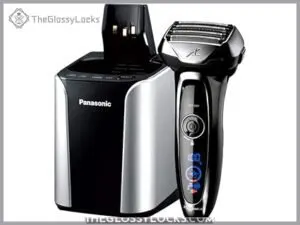
For those with sensitive skin, the Panasonic Arc5 Electric Razor stands out from the crowd.
Its 5-blade shaving system with hypoallergenic stainless steel components minimizes irritation while delivering a remarkably close shave.
You’ll appreciate how the advanced shave sensor technology adjusts power 14 times per second, adapting to your beard’s density.
The 16-D shaving head pivots in multiple directions, following your face’s contours to reduce repeated strokes.
With its 14,000 CPM linear motor and wet/dry capability, you’re looking at a versatile powerhouse that’ll treat your sensitive skin with the respect it deserves, utilizing hypoallergenic stainless steel components.
Best For: Men with sensitive skin who want a versatile electric razor that delivers a close shave with minimal irritation.
- Hypoallergenic stainless steel blades reduce skin irritation.
- Advanced shave sensor adjusts power for optimal comfort.
- Wet and dry shaving capabilities enhance flexibility and convenience.
- Replacement parts can be expensive.
- Cleaning cycle is loud and lengthy.
- Initial price may be higher than basic shavers.
2. Braun Series 9 Pro Electric Razor
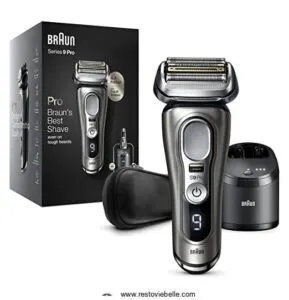
When your sensitive skin demands a premium solution, the Braun Series 9 Pro 9465cc delivers with its innovative ProComfort head that gently massages beard hairs before cutting them.
You’ll appreciate the AutoSense technology that adapts to your beard density, while the titanium-coated blades glide smoothly across your face.
The 5-in-1 cleaning station maintains hygiene without any effort on your part, and this German-engineered marvel provides 60 minutes of cordless shaving and works wonderfully wet or dry.
Your neck and sideburns will thank you, making it a worthwhile investment for premium solution to your grooming needs.
Best For: Those with sensitive skin or dense beards seeking a premium electric shaver with advanced features for a close, comfortable, and efficient shave.
- AutoSense technology adapts to beard density for a personalized shave.
- 5-in-1 cleaning station ensures hygiene, convenience, and long-term durability.
- Versatile wet and dry use with titanium-coated blades for smooth shaving.
- Expensive compared to other electric shavers.
- Noisy operation during use, especially compared to rotary models.
- Instructions rely heavily on illustrations, lacking detailed guidance.
3. Gillette SkinGuard Razor for Sensitive Skin
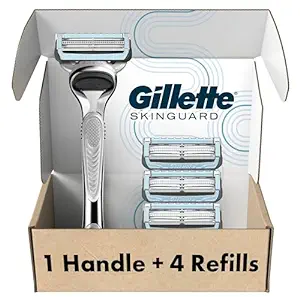
For those up against persistent razor bumps and irritation, the Gillette SkinGuard offers a game-changing solution.
Its innovative design features just two blades with a specialized guard that minimizes skin contact while effectively cutting hair at skin level.
You’ll appreciate the lubrication strips before and after the blades, creating a smooth glide that protects sensitive skin.
The precision trimmer on the back handles detailing work with ease, and while it may require multiple passes for that ultra-close shave, the trade-off is worth it—significantly reduced irritation, fewer cuts, and virtually no razor bumps.
Best For: Men with sensitive skin who experience razor bumps and irritation from traditional razors.
- Reduces razor bumps and irritation.
- Lubrication strips provide smooth glide and added comfort.
- Precision trimmer allows for detailed grooming and styling.
- Requires multiple passes for a closer shave.
- Slightly less effective on body hair compared to facial hair.
- May feel over-lubricated for some users.
4. Philips Norelco OneBlade Trimmer Shaver
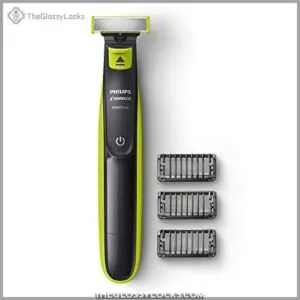
The Philips Norelco OneBlade offers a revolution for sensitive-skinned shavers.
This hybrid trimmer-shaver features dual-sided precision blades that trim, edge, and shave any hair length without irritation.
Its 360-degree pivoting technology follows your facial contours while the fast-moving cutter (12,000 cuts per minute) works with a dual protection system to cut hair, not skin.
You’ll appreciate that it’s waterproof for wet or dry use and doesn’t require shaving foam.
The OneBlade also features AquaTec for wet or dry use.
While replacement blades are somewhat pricey, they last up to 4 months, making the OneBlade an excellent investment for comfortable, irritation-free grooming.
Best For: Those seeking a versatile, irritation-free grooming solution for sensitive skin and multiple body areas.
- Comfortable shaving with minimal irritation, even for sensitive skin.
- Dual-sided blade and 360-degree pivoting head for precise trimming and contouring.
- Waterproof design allows for wet or dry shaving without shaving foam.
- Replacement blades are expensive despite their longevity.
- Does not shave as closely as traditional razors, which may not suit all preferences.
- Hair scatter during use can create a mess due to no built-in hair catcher.
5. Harrys Shave Kit for Men Charcoal
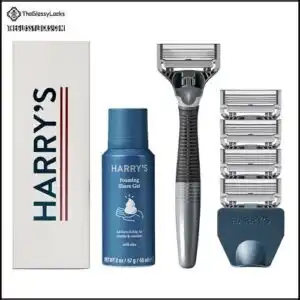
Discover affordability and precision with Harry’s Shave Kit for Men Charcoal.
This compact kit includes a weighted Truman handle with no-slip grip, five German-engineered blades, and soothing Foaming Shave Gel.
You’ll appreciate the flex hinge design that adapts to facial contours while the lubricating strip provides extra protection for sensitive skin.
The precision trimmer handles those tricky areas with ease.
At under $20, you’re getting exceptional value without compromising quality.
Users report fewer nicks and reduced irritation compared to leading brands, making this an excellent choice for sensitive skin.
Best For: Those seeking an affordable, high-quality shaving experience with reduced skin irritation and precision for sensitive skin.
- Weighted handle with ergonomic no-slip grip for better control.
- Five German-engineered blades ensure durability and a close shave.
- Foaming Shave Gel with aloe provides a smooth, soothing experience.
- Not recommended for head shaving.
- Some users notice faster hair regrowth.
- Potential for ingrown hairs in certain skin types.
6. Bulldog Sensitive Razor with Stand
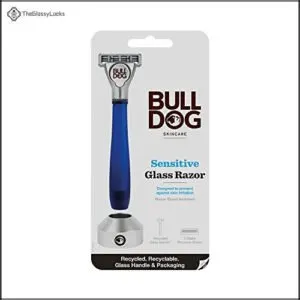
The eco-conscious Bulldog Sensitive Razor with Stand offers a unique combination of sustainability and gentle shaving.
Made from 70% recycled beer bottles, its glass handle pairs with five tempered steel blades and a pivoting head that follows facial contours effortlessly.
The purpose-built lubrication strips with baobab oil guarantee a smooth glide, reducing friction and irritation.
You’ll appreciate the included recyclable metal stand that keeps your razor upright and dry, extending blade life.
The plastic-free packaging aligns with environmental values while the performance delivers a close, comfortable shave that’s perfect for sensitive skin.
Best For: Individuals seeking an eco-friendly razor that provides a gentle, irritation-free shave for sensitive skin.
- Occasional issues reported with razor head detachment.
- Blades and kits sold separately, adding extra cost.
- May not suit users who prefer fully plastic-free handles.
- Made with 70% recycled beer bottles for sustainability.
- Includes lubrication strips with baobab oil for a smooth glide.
- Recyclable metal stand prolongs blade life and reduces waste.
7. GilletteLabs Heated Razor Starter Kit
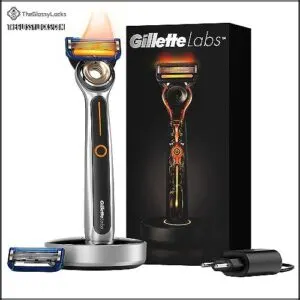
For years, luxury shaving enthusiasts have raved about the GilletteLabs Heated Razor Starter Kit, and it’s easy to see why.
This innovative razor delivers a hot towel sensation at the press of a button, with two temperature settings (109°F and 122°F) that heat up in under a second.
You’ll appreciate how the FlexDisc technology contours to your face, providing consistent warmth that opens pores and reduces irritation.
Though pricey at $100 (down from $149.99), its aluminum zinc handle and magnetic charging dock make this waterproof razor worth considering for sensitive skin.
Best For: Individuals seeking a luxurious, spa-like shaving experience with innovative technology, especially those with sensitive skin.
- High price point, even with discounted pricing at $100.
- Blades require frequent replacements, adding to long-term costs.
- Reports of durability issues and limited battery lifespan.
- Provides a hot towel shave sensation with adjustable heat settings.
- Flexible design contours to the face for consistent comfort and warmth.
- Waterproof construction and magnetic charging dock add convenience.
8. Bevel Shaving Kit for Men
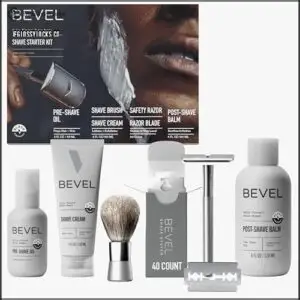
The Bevel Shaving Kit offers a complete five-piece system specifically designed for sensitive skin and curly hair.
With its perfectly weighted brass safety razor, luxury badger brush, and complete skincare lineup, you’ll experience a remarkably close shave without the usual irritation.
The single-blade design substantially reduces razor bumps and ingrown hairs—a game-changer if you’ve struggled with multi-blade cartridges.
Users consistently praise how the pre-shave oil, shave cream, and alcohol-free balm work together to protect and nourish skin throughout the process, making it particularly effective for coarse facial hair that typically causes irritation.
Best For: Men with sensitive or coarse facial hair, especially those prone to razor bumps and irritation.
- Issues with packaging and product condition upon delivery.
- Higher price point compared to other shaving kits.
- Some users report concerns about hygiene due to tampered items.
- Provides a close, irritation-free shave with a single-blade design.
- Includes a complete five-piece system designed for skin protection and nourishment.
- Alcohol-free balm and pre-shave oil are ideal for sensitive or dry skin.
9. Merkur Futur Adjustable Safety Razor
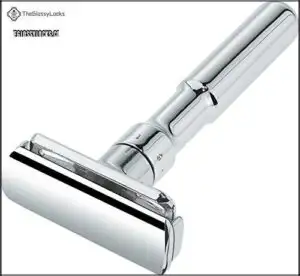
Crafted in Germany with precision engineering, the Merkur Futur Adjustable Safety Razor offers you complete control over your shaving experience.
Its adjustable blade gap lets you fine-tune the aggressiveness for your skin’s needs, while the high-quality brass construction guarantees it’ll be your shaving companion for years.
You’ll appreciate the snap-on cap design for easy blade replacement.
It’s not for beginners—even at the lowest setting, it demands a light touch and proper technique, but master this razor, and you’ll enjoy irritation-free shaves with substantial long-term savings.
Best For: Experienced wet shavers or those seeking a long-term, cost-effective shaving solution with adjustable control.
- Not beginner-friendly due to its aggressive nature.
- Requires precise handling to avoid nicks and cuts.
- Snap-on cap may wear out with repeated use.
- Adjustable settings for personalized shaving comfort.
- Durable brass construction with a corrosion-resistant finish.
- Cost-effective compared to cartridge razors over time.
Shaving Techniques Matter
You’ll substantially reduce irritation and achieve a smoother shave by mastering proper techniques, even with the best safety razor for sensitive skin.
Your technique matters just as much as your equipment, from the direction you shave to how much pressure you apply, which is crucial for a good shave with proper techniques.
Pre-Shave Preparation for Sensitive Skin
Now that you’ve chosen your razor, proper prep is your secret weapon against irritation.
Begin with warm water to open pores, then apply a hot towel for 30 seconds to further soften hair.
Many men with sensitive skin skip the essential step of using preshave oil, which creates a protective barrier. Consider oil for sensitive skin to minimize irritation.
Follow with a quality shave cream and gentle exfoliation to remove dead skin cells before your blade touches your face.
Shaving Direction for Sensitive Skin
Ever wondered why the direction you shave matters so much for sensitive skin? When using a safety razor, shaving with the grain follows your hair growth pattern and substantially reduces irritation.
When shaving sensitive skin with a safety razor, respecting your hair’s natural growth direction isn’t optional—it’s essential for irritation-free results.
Here’s why grain mapping importance can’t be overstated:
- Shaving with the grain minimizes friction and tugging
- Multi-directional shaving techniques should adapt to facial contours
- Ideal stroke direction prevents ingrown hairs
- Slow, steady strokes provide better control for sensitive skin
- Weekly exfoliation prepares skin for smoother shaving technique
To further enhance comfort, consider soaking in warm water beforehand, which is a crucial step for achieving a smoother shaving technique and reducing the risk of ingrown hairs.
Post-Shave Care for Sensitive Skin
Now that you’ve mastered the right shaving direction, your skin needs immediate attention.
After rinsing with cool water, pat—don’t rub—your face dry. Hydration importance can’t be overstated; apply an alcohol-free balm with soothing ingredients like aloe or chamomile.
Consider using a quality post-shave product for ideal skin recovery.
Irritation prevention means skipping aftershaves with alcohol, which can trigger post-shave irritation. For shaving sensitive skin, remember: what you do afterward matters just as much as the razor you choose. Irritation prevention is key to maintaining healthy skin.
Maintaining Safety Razor
You’ll extend your safety razor’s life and keep irritation at bay with proper maintenance that includes regular cleaning and proper storage.
Just like your car needs an oil change, your razor needs fresh blades every 5-7 shaves to guarantee peak performance for your sensitive skin.
Cleaning and Sanitizing Your Safety Razor
Now that you’ve mastered better shaving techniques, let’s keep your safety razor in top condition. Proper cleaning prevents bacteria buildup that can irritate sensitive skin.
Here’s how to maintain your razor:
- Rinse thoroughly after each use to remove hair and product residue
- Deep clean weekly using warm water and mild soap
- Disinfect monthly with isopropyl alcohol (70%)
- Air dry completely to prevent rust
- Disassemble occasionally for thorough residue removal
By following these steps, you can ensure your razor remains in good condition and continues to provide a comfortable shaving experience, which is especially important for sensitive skin.
Storing Your Safety Razor for Optimal Performance
Three essential elements of safety razor storage can make or break your blade’s performance.
Keep your razor dry and rust-free by storing it upright in a stand after each use.
"A dry razor is a happy razor," as my grandfather used to say—and he never experienced skin irritation!
| Storage Method | Benefits | Best For |
|---|---|---|
| Razor Stand | Promotes air drying, prevents rust | Daily use |
| Travel Case | Protects components, secure blade storage | On-the-go shavers |
| Bathroom Cabinet | Minimizes humidity exposure | Limited counter space |
| Silica Gel Pouch | Absorbs excess moisture | Humid environments |
| Blade Bank | Safely stores used blades | Eco-conscious shavers |
The key to maintaining your razor is to store it in a way that prevents rust and keeps it dry, which is why methods like using a razor stand are beneficial.
Replacing Your Safety Razor Blades
While proper storage keeps your razor pristine, knowing when to swap blades is equally important.
For sensitive skin, replace safety razor blades after 5-7 shaves—dull edges cause irritation faster than sharp ones, look for signs like tugging or redness.
Most safety razors accept universal blades, but check compatibility with your specific model, and remember proper blade disposal using a blade bank to keep everyone safe.
Dealing With Sensitive Skin
You’ll recognize sensitive skin by its telltale signs of redness, burning, or small bumps that appear after shaving with the wrong razor.
Understanding these symptoms, which often result from irritant contact dermatitis or allergic reactions to certain metals, will help you select the perfect safety razor that actually prevents irritation rather than causing it, by considering the impact of irritant contact dermatitis.
Identifying Sensitive Skin Signs and Symptoms
Recognizing sensitive skin symptoms is your first defense against shaving woes.
Your skin is likely sensitive if you notice:
- Persistent skin redness that lingers hours after shaving
- Burning sensations when applying products that never bothered you before
- Unexpected itchiness causes that seem to worsen with certain razors
- Texture changes or dryness signs appearing within minutes of shaving
Don’t ignore these skin reactions—they’re your body’s distress signals! You should take them seriously as they indicate sensitive skin and can lead to further skin reactions if not addressed properly.
Common Redness Indicators in Sensitive Skin
Looking out for redness after shaving can help you identify the right sensitive skin razor.
Redness isn’t just annoyance—it’s your skin communicating distress.
| Redness Type | Duration | Possible Cause |
|---|---|---|
| Bright, immediate | 1-2 hours | Product ingredient reactions |
| Patchy, delayed | 12-24 hours | Underlying skin conditions |
| Persistent | Several days | Environmental factor impact |
Pay attention to post-shave redness patterns—they’re clues to finding the perfect razor for your skin irritation issues.
Breakouts and Acne-Like Symptoms in Sensitive Skin
Many sensitive-skinned shavers confuse post-shave breakouts with acne, when they’re often something different entirely.
Razor bumps and ingrown hairs can mimic acne symptoms but stem from improper shaving technique.
Folliculitis causes inflammation when bacteria invade hair follicles, while rosacea produces acne-like bumps from different triggers.
Using the right razor for bumps and maintaining your skin barrier can prevent these issues.
Don’t treat these conditions with harsh acne products—they’ll worsen skin irritation.
Excess sebum production can also lead to breakouts, so it’s important to keep skin clean by using non-comedogenic products.
Frequently Asked Questions (FAQs)
Should you use a safety razor If you have sensitive skin?
Like a gentle whisper on tender skin, you’ll find safety razors are actually ideal for sensitivity.
Their single blade reduces irritation, while adjustable options let you control aggression.
You’ll enjoy fewer ingrown hairs and smoother results.
Are safety razors safe?
Yes, safety razors are safe when you use proper technique.
They’re designed with a protective bar that limits blade exposure, reducing your risk of cuts while still giving you a close, irritation-free shave, using a protective bar.
What are the best safety razor blades for sensitive skin?
Gentle as a whisper, your sensitive skin will thank you for choosing Astra Superior Platinum, Derby Extra, or Feather blades.
You’ll find these platinum-coated options provide the perfect balance of sharpness and comfort.
How do I choose a sensitive skin-friendly razor?
Look for razors with fewer blades, pivoting heads, and lubrication strips.
You’ll want biocompatible materials like stainless steel or titanium.
Consider adjustable options that let you customize the aggressiveness of your shave.
Which Razor is best for sensitive skin?
While cartridge razors irritate, safety razors soothe.
For your sensitive skin, try the Feather AS-D2 or Rockwell 6S—both offer mild shaves with quality materials.
You’ll notice less redness and irritation immediately.
Which Shaver is best for sensitive skin?
For sensitive skin, the Feather AS-D2 safety razor is your best bet.
Its mild shave and well-designed structure will help you avoid irritation while still getting a close, comfortable shave every time.
Do dermatologists recommend safety razors?
Yes, many dermatologists recommend safety razors for their single-blade design.
You’ll experience less irritation, ingrown hairs, and razor burn compared to multi-blade cartridges.
They’re especially helpful if you’ve got easily irritated skin.
Which is the mildest safety razor?
Ever wondered about the gentlest shave possible?
The Feather AS-D2 is considered the mildest safety razor, with its well-designed, second-generation model offering a supremely gentle approach that’ll keep your sensitive skin happy.
What is the best razor for sensitive skin dermatologist?
Dermatologists often recommend the Feather AS-D2 for your sensitive skin.
You’ll appreciate its mild shave, stainless steel construction, and precision design.
It’s gentle like a feather but effective against stubborn stubble.
How do you prevent razor burn with a safety razor?
Banish razor burn forever.
Prep with warm water, use quality shaving cream, hold the razor at a 30° angle, apply light pressure, shave with the grain.
Always follow with cold water and moisturizer to ensure the best results after shaving, this step is crucial for complete skin comfort.
Conclusion
Will your sensitive skin finally find peace?
After exploring these top safety razors, you’re now equipped to make the right choice.
Remember, the best safety razor for sensitive skin isn’t just about the tool—it’s about your technique and routine too.
With proper preparation, technique, and aftercare, you’ll transform shaving from a dreaded chore into a comfortable ritual.
Your perfect match awaits, promising smoother skin and fewer irritations with every shave.

